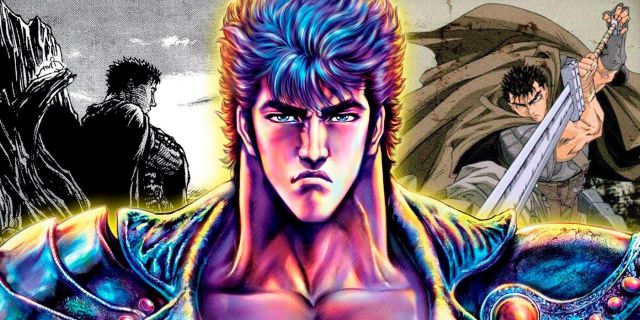Berserk is considered one of the most notable influences of dark fantasy in media, cited to have inspired the world of the Dark Souls series and the now-popular character theme of the hero with a big sword. It was first published in 1989 and is continuing now, though under the direction of Studio Gaga after the tragic death of author Kentaro Miura. Although Berserk is considered a powerhouse of manga artwork that became a foundation to many other works of a dark fantasy fiction, it too drew from previous art and ideas that came before it.
Fist of the North Star, written by Buronson and illustrated by Tetsuo Hara, is a dystopian martial arts manga that ran through the 1980s. It follows the master of Hokuto, Kenshiro, as he travels across a wasteland caused by nuclear war in search of his fiancée and his exploits of protecting the destroyed world’s populace. On the surface, there seems to be little connecting the two franchises. One is a medieval dark fantasy where the tragic and tormented hero slays monsters; the other is a futuristic dystopian world where the hero spends his days defeating bands of brigands and saving people from the goodness of his heart. Below the surface, however, Fist of the North Star’s inspiration for Berserk is clear as day.
How Fist of the North Star’s Creator Influenced Kentaro Miura

Fist of the North Star was published in 1983, the time when Berserk creator Miura was aspiring to be a manga author himself. After the former series concluded in 1988, Miura actually ended up working for Buronson on a new creative piece, likely taking notes on stylistic and artistic techniques and learning everything he could. Under the tutelage of such a successful author as Buronson, together they created the manga King of Wolves.
It was during this time that Miura wrote and drew the prototype of Berserk. This was the springboard for creating his most famous work, and it started in Buronson’s studio. Whilst there were similarities in the Berserk prototype to Fist of the North Star, it was not until the former’s official release in 1989 that the expansive narrative and style unveiled the inspiration drawn from Buronson’s work. Miura appeared to take what he learned to the pages of his early chapters and adapted Tetsuo Hara’s artistic style to design a completely new and original world of his own.
The Early Artistic Style and Narrative of Berserk

Berserk’s early artwork may not be as refined as the later years, but it was still considered outstanding. One detail certainly taken from Miura’s time studying with Buronson — and likely exploring Hara’s work — is the way gore is drawn. Berserk is certainly a bloody and graphic manga, depicting intense wounds, death and violence. When comparing how Hara depicted the results of Ken’s Hokuto techniques — exploding heads and body parts — with the absolute brutality of Guts’ swordsmanship, the method of innards and fountains of blood follows a similar style. This factor is crucial, as it creates a more authentic and violent world when the portrayal of violence is graphic.
Fist of the North Star did not invent this narrative style — a hero traveling between locations and performing acts is a well-established trope in fiction. Each adventure could initially be viewed through as a singular story within its own right, which was also a common trend in the early doors of anime and manga. Combined with Miura and Buronson’s creative history, it appears more likely that Miura took the concept of the traveling hero to birth his manga and then evolved it through Guts’ characterization. A big difference between the two is the demographic — Fist of the North Star is a shōnen whilst Berserk is a seinen, which helped the inevitable separation of themes and plot.
Similarities and Reflections Between Kenshiro and Guts

At first glance, Fist of the North Star’s Ken and Berserk’s Guts are entirely different characters. Their behaviors and actions are worlds apart and their personalities could even be considered polar opposites. Aside from their appearance — which certainly has similarities in hairstyle, muscular build and facial structure — there is a common theme within their adventure.
Both Ken and Guts travel across their worlds due to a female love interest — Yuria and Casca — and confront a variety of bloodthirsty foes who cause distress for the innocent. Ken defeats raiders and the Nanto Seiken, whilst Guts crushes evil spirits and Apostles. They also attract companions to travel with them who are continually shocked by their otherworldly skill. Both are the best are what they do — and what they do is violence.
Even so, there is a clear contrast between Ken and Guts — an opposite reflection. Both are heroic in their own right and their motivations can be considered somewhat similar in a certain context, but who they have become is vastly different. Ken strives to do good since that’s what his power should be used for, whilst the trauma and suffering Guts has experienced has led him down a darker path. In that respect, Guts could be considered what a man with great strength and power would become had the circumstances differed for Ken. Guts may have been inspired to some degree by Ken, but his in-depth characterization is entirely singular to him.
Though the ultimate implication is that Berserk was inspired by Fist of the North Star, it is an impossible task to locate any work of fiction that was not inspired by something before it. In Berserk’s case, Kentaro Miura took what he learned under Buronson’s guidance — and his experience with Tetsuo Hara’s artistic style — and birthed a creation that went on to influence countless works afterward.















Leave a Reply